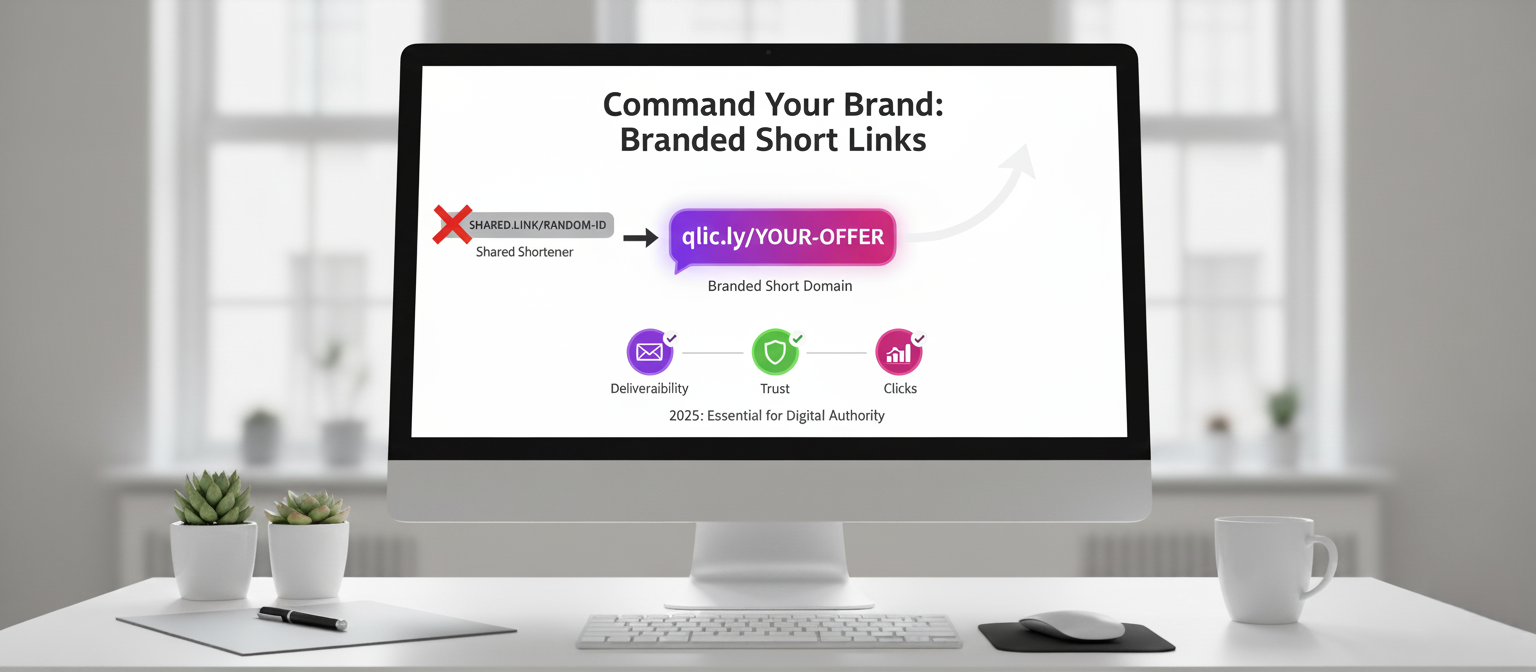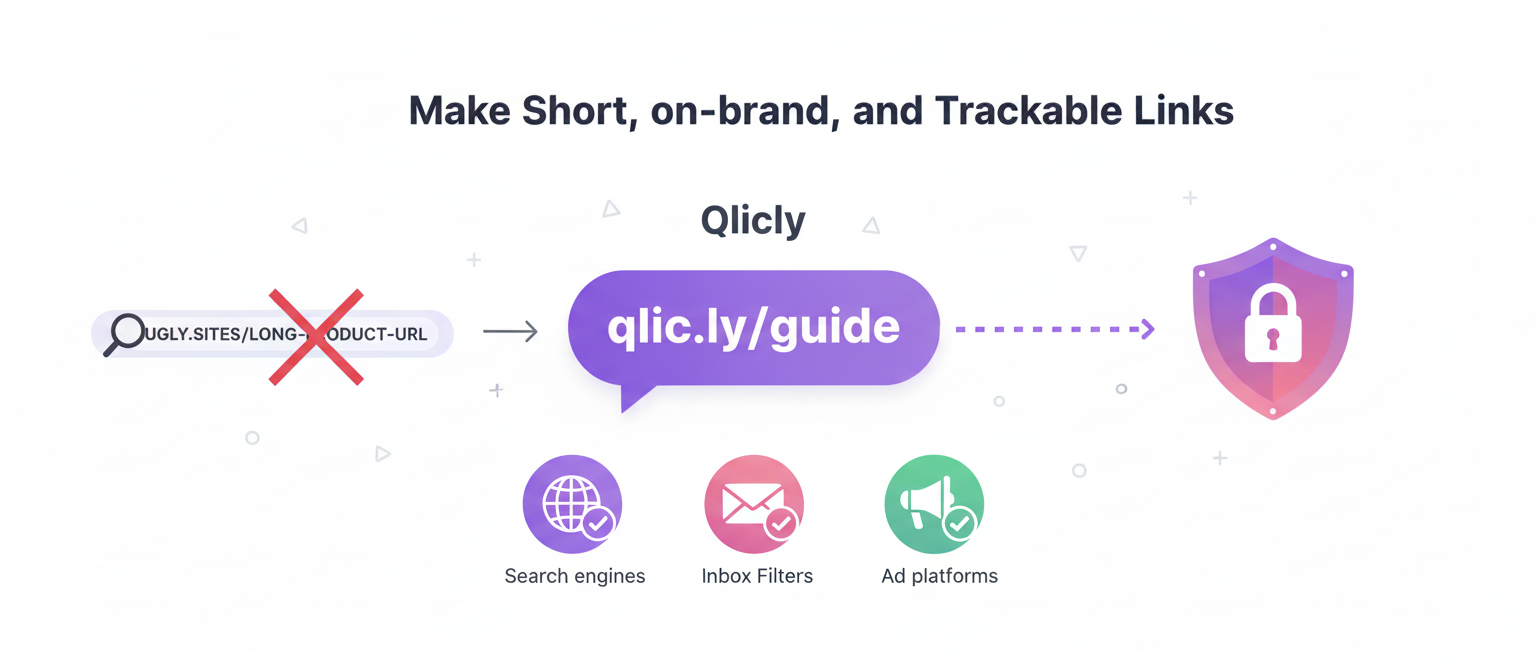
TL;DR: Switching from a shared shortener domain to a branded short domain (e.g., qlic.ly/offer) consistently lifts click-through rates, builds user trust, and can improve email/SMS deliverability by aligning links with your brand’s reputation. In 2025, this isn’t a nice-to-have—it’s table stakes for serious growth.
What is a Branded Short Domain?
A branded short domain is a custom, memorable domain you control for shortening and routing links—think es.pn (ESPN), on.wsj.com (The Wall Street Journal), amzn.to (Amazon), or nyti.ms (The New York Times). Evidence of usage includes official docs and live links (e.g., WSJ’s on.wsj.com subscription link).[13][14][15][16]
On Qlicly, you can add your own branded domain, create short links, deep link into apps, A/B test destinations, and analyze performance. You can also automate domain and link ops via API for scale (see Branded Domains and the Developer API).
Why Branded Domains Lift CTR
People click what they recognize. Multiple datasets show consistent gains:
- Bitly case study: Across hundreds of brands, branded short domains drove up to 34% higher CTR than unbranded links.[1]
- Rebrandly experiments: Controlled tests reported up to 39% more clicks for branded links versus generic short URLs.[2]
Gains come from immediate brand recognition in the URL, which reduces uncertainty and scanning time. Short, readable slugs also increase processing fluency—the cognitive ease that nudges clicks and conversions.
Psychology at Work
- Trust heuristics: Users treat the domain as a safety cue; a clear brand in the hostname appears less risky than an obscure domain with a random slug. Security teams similarly flag opaque redirect chains more often.[11]
- Processing fluency: Short, readable URLs are parsed faster, correlating with higher click probability.
- Consistency bias: Repetition of your brand in the link reinforces recognition across channels, compounding results over time.
Trust and Safety: Brand Alignment Matters
Security and deliverability systems scrutinize the domains inside your messages. Mail providers and filters assess the reputation of the root domain behind tracked links; SendGrid’s documentation frames “link branding” as serving click-tracked links “from your domain,” which helps filters evaluate trust based on your domain’s reputation.[3]
Email Deliverability in 2025: Reduce Friction, Respect Filters
Mailbox providers score domains, not just IPs. In 2024–2025 guidance, Gmail and Yahoo emphasize authentication and domain alignment for bulk senders (SPF, DKIM, DMARC).[4][5]
- Authenticate rigorously: Implement SPF, DKIM, and DMARC on your sending domain (required for high-volume senders at Gmail/Yahoo).[4][5]
- Align your tracking/redirect domain: Use a branded tracking domain (e.g.,
link.yourbrand.com) so each link leverages your domain reputation; see SendGrid’s link branding guidance.[3] - Minimize redirect hops: Avoid multi-hop chains (e.g.,
shortener → tracker → ad server → landing); excess hops are a risk signal for scanners and filters. - Use HTTPS everywhere: Ensure your tracking domain supports HTTPS for engagement tracking (SparkPost/Mailgun provide options).[6][7]
- Own your analytics: First-party click data keeps attribution clean and privacy-resilient.
SMS & 10DLC: Why Public Shorteners Get Filtered
Carrier filtering has tightened. U.S. carrier-aligned guidance and messaging providers discourage public/shared URL shorteners in A2P SMS due to abuse; best practice is a branded, proprietary domain.[8][9][10]
- Do: Use your own branded domain in SMS, register compliant 10DLC campaigns, and keep content transparent.
- Don’t: Use free/public shorteners in bulk messaging—they’re widely filtered, with little recourse.
SEO & Analytics Benefits
Branded short links don’t replace canonical URLs for SEO, but they support discoverability and measurement:
- Cleaner previews: Branded hostnames can increase trust on social cards and paid ads, positively influencing CTR.
- First-party analytics: Owning the redirect domain keeps clickstream data in your stack; tag links, add UTMs, run A/B tests, and analyze performance by channel.
How to Implement a Branded Short Domain with Qlicly
- Choose a short, on-brand domain: Keep it pronounceable and close to your brand name (e.g.,
brand.co,go.brand, or a thoughtful TLD hack). - Connect the domain in Qlicly: Point DNS (typically a CNAME) and verify in Settings → Branded Domains — see Branded Domains.
- Harden for email/SMS: Use HTTPS on your tracking domain; align link branding with your sender identity.[6][7]
- Standardize your slugs: Create naming conventions (
/spring-promo,/press-kit,/careers) and enforce them via team guidelines. - Instrument everything: Add UTM parameters, pixels, and destination rules (geo/device/language targeting, deep links) to tailor by audience.
- Automate at scale: Use Qlicly’s API to bulk create and manage links, rotate destinations, and drive programmatic governance.
Real-World Examples
- ESPN: Uses
es.pnfor branded short links (documented in Bitly support and common usage likees.pn/activate).[13][17] - Wall Street Journal: Uses
on.wsj.com(live offer links/private feeds use this domain).[14] - Amazon: Commonly uses
amzn.toin short links and permalinks.[15] - The New York Times: Uses
nyti.msas a branded short domain.[16]
Best Practices Checklist (2025)
- Use a branded short domain everywhere links appear (ads, social, email, SMS, QR).
- Keep slugs human-readable; avoid opaque IDs unless testing.
- Limit redirect hops and ensure TLS (HTTPS) on your tracking domain.[6][7]
- Authenticate email (SPF, DKIM, DMARC) and align link identity with your brand domain.[4][5]
- Rotate or retire old links; keep destinations fresh and relevant.
- Monitor domain reputation and carrier feedback; avoid shared public shorteners in SMS.[8][9]
Choosing the Right Branded Domain
Great branded domains are short, pronounceable, and unmistakably tied to your brand. Practical tips:
- Keep it close to your name: Favor
brand.co,go.brand, or smart TLD hacks (es.pn,nyti.ms). - Prioritize clarity over cleverness: If users need to think twice, you’ve lost the “at-a-glance” advantage.
- Plan for HTTPS and DNS control: You’ll typically add a CNAME for your tracking host; ensure TLS is enabled for secure redirects.[6][7]
- Standardize slugs and tagging: Use consistent structures (e.g.,
/utm-campaign, channel tags) so reporting is clean across teams.
How Much Lift to Expect (and How to Prove It)
Industry data points set realistic expectations: Bitly’s dataset shows up to 34% higher CTR with branded domains; Rebrandly reports up to 39% more clicks. Your exact lift depends on audience, channel mix, and link visibility.[1][2]
- Design a simple A/B: Keep creative/copy identical. Only swap the link: generic shortener vs. branded domain. Run to statistical confidence.
- Measure downstream: Track conversions, bounce rate, and time on page to confirm that higher CTR = quality traffic.
- Iterate the slug: Human-readable slugs (
/pricing,/webinar-invite) often outperform opaque IDs. - Watch deliverability signals: For email, monitor inbox placement/complaints; for SMS, monitor carrier errors and opt-outs as you switch.[9][10]
Migrating from a Public Shortener
Plan the migration to preserve analytics and minimize breakage:
- Inventory and prioritize: Export existing links and tag by traffic/importance. Migrate high-impact links first.
- Recreate destinations and slugs: In Qlicly, rebuild priority links with readable slugs and UTMs; use campaigns/channels.
- Update templates and automations: Swap email/SMS templates, ad macros, and social schedulers to your branded domain.
- Set redirects or replace: Where possible, update the source link; otherwise replace at the distribution layer.
- Monitor and roll forward: Track CTR, conversions, inbox placement, and SMS delivery. Expect compounding gains as users learn the new host.
Advanced Tactics that Compound Results
- Deep linking to apps: Send mobile users directly into your app when installed, or to the app store when not.
- Smart targeting: Route by country, language, or device—one link, many experiences.
- A/B tests on destinations: Split traffic across variants to optimize conversion pages without changing creative.
- QR synergy: Mirror the same branded domain in offline channels; branded QR + branded links reinforce recognition.
- Pixels & analytics: Attach pixels to short links (where permitted) to measure lift from specific placements.
Governance & Security for Teams
As links become mission-critical infrastructure, tighten governance:
- Role-based access: Assign privileges for creating, editing, and retiring links.
- Naming and ownership: Adopt conventions for slugs, tag owners, and campaign IDs to avoid collisions.
- Expiration & revocation: For time-bound campaigns, redirect retired links to evergreen pages or purposeful 404s.
- HTTPS enforcement: Periodically audit for HTTPS and cert health across tracking hosts.[6][7]
- Abuse monitoring: Watch for abnormal click patterns and blocklists. Public shorteners are frequent abuse targets; owning the domain reduces collateral risk.[11]
Getting Started with Qlicly
Qlicly makes branded domains simple: add your domain, shorten links, and track performance—all in one dashboard. Features like deep linking, A/B testing, QR codes, bio pages, and robust analytics help you turn every link into a performance lever. If you’re scaling, the API gives you programmatic control to create, tag, rotate, and report at volume. Explore Branded Domains to set this up in minutes.
Conclusion
In 2025, branded short domains are a high-leverage upgrade. They lift CTR through instant recognition, reinforce trust across every touchpoint, and support deliverability by aligning link identity with modern filtering logic. Put your brand where it matters—right in the link—and let the data compound.
References
- Bitly. (2015). Branded Short Domains Drive up to a 34% Increase in CTR. PDF.
- Rebrandly. (n.d.). Generic Short URLs vs Branded Links: Which Has Better CTR? Article.
- Twilio SendGrid Docs. (n.d.). How to set up link branding. Guide.
- Google Workspace Admin Help. (2024–2025). Email sender guidelines. Help Center.
- Yahoo Sender Hub. (n.d.). FAQs (DMARC guidance). Page.
- SparkPost Support. (2025). Enabling HTTPS Engagement Tracking on SparkPost. Doc.
- Mailgun Help Center. (2025). HTTPS Tracking & Links. Doc.
- Sinch. (2024). US SMS Compliance Guide (PDF). Guide.
- Bandwidth. (2025). Messaging URL best practices. Support.
- Salesforce Help. (2024). Messaging references re: carrier filtering (shortened URLs problematic). Article.
- Menlo Security. (2023). URL shortening allows threats to evade URL filtering and categorization tools. Blog.
- SparkPost Support. (2021–2025). Custom/engagement tracking domains. Overview.
- Bitly Support. (2025). What is a custom domain? (ESPN
es.pnexample). Support. - The Wall Street Journal. (n.d.). on.wsj.com live link example. Link.
- Juliet Rich. (2019). 3 Ways to Make an Amazon Short URL Link (shows
amzn.to/). Post. - Netify. (n.d.). nyti.ms – Domain Info. Record.




